Abstract
Background
The aim of this study was to determine the accuracy and error range of hand grip strength measurement using various methods.
Methods
Methods used for measurement of hand grip strength in 34 epidemiologic studies on sarcopenia were analyzed. Maximum grip strength was measured in a sitting position with the elbow flexed at 90 degrees, the shoulder in 0 degrees flexion, and the wrist in neutral position (0 degrees). Maximum grip strength in standing position was measured with the shoulder in 180 degrees flexion, the elbow fully extended, and the wrist in neutral position (0 degrees). Three measurements were taken on each side at 30 sec intervals. The uncertainty of measurement was calculated.
Results
The combined uncertainty in sitting position on the right and left sides was 1.14% and 0.38%, respectively, and the combined uncertainty in standing position on the right and left sides was 0.35 and 1.20, respectively. The expanded uncertainty in sitting position on the right and left sides was 2.28 and 0.79, respectively, and the expanded uncertainty in standing position on the right and left sides was 0.71 and 2.41, respectively (k=2).
While the hand grip strength has been mainly used to evaluate the function of the hand when injured, it has recently been widely used for the diagnosis and evaluation of physical activity in sarcopenia.[12]
The hand grip strength method is relatively simple and has the advantage of being able to cost-effectively measure the skeletal muscle strength of the patient.[3] However, the measurement results of the hand grip strength are influenced by the subjects' conditions such as the measurement posture, the dominant side of the hand, the size of the hand, the number of repeated measurements, their height and weight, etc.[4567] In addition, various measuring methods can be used, such as digital, analog, hydraulic, and Smedley types. This difference among the measurement methods and measuring machines can induce a discrepancy among the results.[89]
In our previous study, a systematic review was performed of the hand grip strength measurement method used in sarcopenia related epidemiologic studies. It was suggested that the most frequently used hand grip strength measurement methods.[6]
Therefore, the aim of this study was to present the accuracy and error range of hand grip strength measurement by measuring the errors of the machine and of the methods presented in the previous study. In addition, in this study, the measurement uncertainty of the measurement for hand grip strength was calculated using a hand dynamometer with traceability.
The design and protocol of this prospective study were approved by the Institutional Review Board (IRB) of our hospital (IRB No. GNUH 2017-09-004). A 30-year-old male volunteer without disease or injury on both sides of his hands was enrolled in this study.
A comprehensive search for relevant randomized controlled trials and comparative studies was conducted through PubMed, OVID Medline, Cochrane Collaboration Library, Web of Science, EMBASE, KoreaMed, and AHRQ between January 2009 and December 2016 with English language restriction. Studies were selected based on the following inclusion criteria: (1) community dwelling participants aged 65 years and older using population based sampling approach; (2) hand grip strength was assessed according to the European Working Group on Sarcopenia in Older People, the Asian Working Group for Sarcopenia, or the International Working Group on Sarcopenia definitions of sarcopenia; (3) studies were published as full reports, not conference abstracts, and letters to editors, or case-report studies. Studies were excluded if they failed to meet these inclusion criteria.
Thirty-four sarcopenia-related epidemiologic studies were reviewed and methods for measuring grip strength were analyzed (Table 1).
The measurement of hand grip strength of the left and right hands (kgf) was performed using a Smedley type dynamometer (Takei, Japan) (Fig. 1).
The selection of the 2 most commonly used postures (sitting and standing) was based on the review of the related literature.[46] In the sitting position, the elbow was flexed at 90 degrees with the shoulder attached to the torso, with the wrist maintaining a neutral posture (0 degrees) and the grip with maximal strength was measured (Fig. 2).
In a standing position, the shoulder was aligned with the torso, with the elbow fully extended, with the wrist maintaining a neutral position (0 degrees), and the grip with maximal strength was measured (Fig. 3).
The measurements were taken 3 times on each side (left and right sides), and the interval between measurements was 30 sec.
Using the deadweight force standard specified by the Korea Research Institute of Standards and Science (KRISS), 4 calibrations were performed with a unit of 5 kgf loaded up to 70 kgf (Fig. 4). A jig conforming to the deadweight force standard was applied so that the weight could be loaded consistently (Supplemental Fig. 1).
The uncertainty of the grip strength measurement value (Ur) is calculated by statistically analyzing the observed values derived from measuring the 4 different measurement positions (Sitting_Rt, Sitting_Lt, Standing_Rt, Sitting_Lt), 3 times on each side (left and right hand) in each sitting position and standing position.
The calibration uncertainty of the dynamometer (Us) is obtained by comparing the observed values obtained by the 4 measurements of the 14 actual load values of 5 kgf according to the deadweight force standard. The relative expansion uncertainty obtained through the procedure is 0.002%, and the correction uncertainty for each of the 4 measurements (Sitting_Rt, Sitting_Lt, Standing_Rt, Sitting_Lt) is obtained from the average value and standard uncertainty: (standard uncertainty/measurement value)×2=0.002%.[10]
Also, the result of the grip strength measurement is shown up to the second decimal place. Therefore, uncertainties arising from minimal resolution should be included in the uncertainty calculation. The uncertainty was calculated assuming a minimum resolution of 0.1 kgf and a probability distribution as a square distribution.[10]
Relational expression of the model was based on Guide to the Expression of Uncertainty in Measurements and Eurachem and the uncertainty from each of the factors was evaluated. Based on relational expression of the model, we selected 4 factors of uncertainty of measurement. Standard uncertainty and combined uncertainty of measurement were also calculated. Standard uncertainties of calibration curve, internal quality control and inspector precision were measured. Resolution of the equipment was decided to be ignored in the measurements of standard uncertainty. Mean value and standard deviation were calculated after performing repeated measurements of grip strength. Regression analysis was conducted. When measurements are from multiple entry values, the standard uncertainty of the results of the measurements is called combined standard uncertainty, which is acquired by using the law of propagation of uncertainty. In order to obtain the coverage factor k, the effective degree of freedom of the combined standard uncertainty needed to be estimated. Expanded uncertainty was obtained by multiplying the calculated combined standard uncertainty and the inclusion factor k equivalent to confidence level.
According to the uncertainty calculation formula, standard uncertainty and combined uncertainty for one healthy 30-year-old man were acquired.
Table 2 shows the repeated measurements of grip strength while maintaining traceability. Calibration measurements using a force standard meter are shown in Table 3. The combined uncertainty in the sitting position on the right side and the left side was 1.14 and 0.38, respectively, and the combined uncertainty in the standing position on the right side and the left side was 0.35 and 1.20, respectively. The expanded uncertainty in the sitting position on the right side and the left side was 2.28 and 0.79, respectively, and the expanded uncertainty in the standing position on the right side and the left side was 0.71 and 2.41, respectively (k=2) (Table 4).
According to the uncertainty calculation formula, the standard uncertainty and combined uncertainty for the healthy 30-year-old man were determined. The combined uncertainty in the sitting position on the right side and the left side was 1.14 and 0.38, respectively, and the combined uncertainty in the standing position on the right side and the left side was 0.35 and 1.20, respectively. The expanded uncertainty in the sitting position on the right side and the left side was 2.28 and 0.79, respectively, and the expanded uncertainty in the standing position on the right side and the left side was 0.71 and 2.41, respectively (k=2).
Fess [11] stated that, by utilizing an adjustable top workbench, positioning blocks, force collar, standardized test weights, and a careful testing procedure, accurate and consistent measurements using the dynamometer can be achieved, and if calibrated correctly, the dynamometer can be a highly reliable assessment instrument.
Amaral et al.[12] compared the accuracy and precision of measurements of the grip strength of 3 different dynamometers. They stated that the Takei® and Transducer dynamometers demonstrated similar grip strengths in the sample studied. The influence of the formats of handles on the measurement of grip strength was noted as well as the need for prior calibration of this type of instrument. Fess [11] also stated that dynamometers with a correlation coefficient of 0.9994 or better and a difference between the means of 1.5 pounds (0.68 kg) or less do not need recalibration.
Ha et al.[6] conducted a systematic review of the standardized protocol by which the various methods for measuring hand grip strength are compared and analyzed. They stated that a standardized method is needed to enable more consistent measurement of grip strength, and found that other epidemiologic studies measured the hand grip strength in various ways. For consistent measurement and accurate diagnosis of sarcopenia, this study adopted the method suggested by Ha et al.[6] in which the subject uses the Smedley-type dynamometer while in a standing position, achieving maximum grip strength 3 times with both the left and right hands.
Roberts et al.[4] stated that the Jamar® hand dynamometer, which is the most widely cited instrument in the literature, appears to be generally accepted as the gold standard by which other dynamometers are evaluated and has the most normative data.
A standardized method for measurement of hand grip strength needs to be established and adopted. Setting up a standardized protocol for measuring hand grip strength can be explained in 2 ways: (1) correctly calibrating the dynamometer; and (2) taking measurements such as posture or the side of the hand of the subjects. This study suggests the presence of uncertainty in terms of the standardization of both the dynamometer and the protocol, and emphasizes the need to standardize the method. A more appropriate device for measurement of hand grip strength for sarcopenic patients also needs to be developed, considering that most sarcopenic patients can barely sustain a hand grip in a consistent position or are often not able to apply grip strength for the sufficient amount of time needed for evaluation.
According to Robert et al.[4], the Jamar® hand dynamometer is the most commonly selected tool for assessment of grip strength, as it has the most normative data. They also state that an adequate number of epidemiologic studies must be performed concerning hand size, hand dominance, position, joint condition, effort and encouragement, frequency of the test, time of day, and proficiency of the assessor in order to establish normative data to develop a dynamometer for sarcopenia patients.
In October 2016, the disease classification code (International Classification of Diseases, 10th revision code) was prescribed for sarcopenia.[13] While this introduced the need for more established criteria for diagnosis, these criteria have not yet been clarified. Although hand grip strength measurement is the most important criterion in the diagnosis of sarcopenia, this study shows a significant difference between the actual measured value and the indicated value. In the future, calibration and standardization work will be carried out for a large number of force measuring devices. Furthermore, various muscle strength measuring devices need to be standardized in order to accurately diagnose and treat sarcopenia.
This study has several limitations. First, to calculate the uncertainty, only a representative process critical to quality control was applied in the process of measuring the hand grip strength. Using the uncertainty calculation formula provided, future studies will need to calculate the uncertainty with the standard values from all processes. Second, a direct comparison was difficult due to the limited available medical data for calculating the uncertainty. Since the importance of standard values and calculation of uncertainty are emphasized in the medical and industrial sectors, these study findings will become increasingly more valuable.
In conclusion, the uncertainty of measurement of hand grip strength was identified in this study, and a significant difference between measurement and indication was observed. For more precise establishment of an index for diagnosis of sarcopenia, dynamometers will need to be correctly calibrated to address such uncertainty.
ACKNOWLEDGMENTS
This research was supported (in part) by the Ministry of Trade, Industry and Energy (MTIE) through the Standard Reference Data Program.
References
1. Lin DC, Chang JH, Shieh SJ, et al. Prediction of hand strength by hand injury severity scoring system in hand injured patients. Disabil Rehabil. 2012; 34:423–428.

2. Eriksen CS, Garde E, Reislev NL, et al. Physical activity as intervention for age-related loss of muscle mass and function: protocol for a randomised controlled trial (the LISA study). BMJ Open. 2016; 6:e012951.

3. Beseler MR, Rubio C, Duarte E, et al. Clinical effectiveness of grip strength in predicting ambulation of elderly inpatients. Clin Interv Aging. 2014; 9:1873–1877.
4. Roberts HC, Denison HJ, Martin HJ, et al. A review of the measurement of grip strength in clinical and epidemiological studies: towards a standardised approach. Age Ageing. 2011; 40:423–429.

5. Petersen P, Petrick M, Connor H, et al. Grip strength and hand dominance: challenging the 10% rule. Am J Occup Ther. 1989; 43:444–447.

6. Ha YC, Hwang SC, Song SY, et al. Hand grip strength measurement in different epidemiologic studies using various methods for diagnosis of sarcopenia: a systematic review. Eur Geriatr Med. 2018; 9:277–288.

8. Dodds RM, Syddall HE, Cooper R, et al. Global variation in grip strength: a systematic review and meta-analysis of normative data. Age Ageing. 2016; 45:209–216.

9. Beaton DE, O'Driscoll SW, Richards RR. Grip strength testing using the BTE work simulator and the Jamar dynamometer: a comparative study. Baltimore Therapeutic Equipment. J Hand Surg Am. 1995; 20:293–298.

10. Lequin RM. Guide to the expression of uncertainty of measurement: point/counterpoint. Clin Chem. 2004; 50:977–978.





 PDF
PDF ePub
ePub Citation
Citation Print
Print


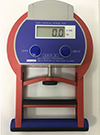
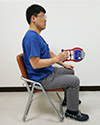

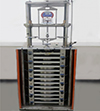
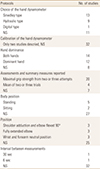


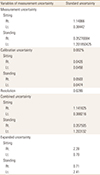
 XML Download
XML Download